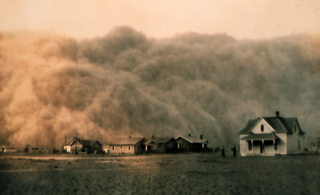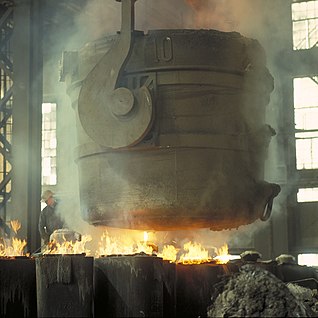
A ceramic is a solid material comprising an inorganic compound of metal, non-metal or metalloid atoms primarily held in ionic and covalent bonds. Common examples are earthenware, porcelain, and brick.

Glass fiber is a material consisting of numerous extremely fine fibers of glass.

Pyrex is a brand introduced by Corning Inc. in 1915 for a line of clear, low-thermal-expansion borosilicate glass used for laboratory glassware and kitchenware. It was later expanded to include clear and opal ware products made of soda-lime glass.

Fused quartz or fused silica is glass consisting of silica in amorphous (non-crystalline) form. It differs from traditional glasses in containing no other ingredients, which are typically added to glass to lower the melt temperature. Fused silica, therefore, has high working and melting temperatures. Although the terms fused quartz and fused silica are used interchangeably, the optical and thermal properties of fused silica are superior to those of fused quartz and other types of glass due to its purity. For these reasons, it finds use in situations such as semiconductor fabrication and laboratory equipment. It transmits ultraviolet better than other glasses, so is used to make lenses and optics for the ultraviolet spectrum. The low coefficient of thermal expansion of fused quartz makes it a useful material for precision mirror substrates.

Many ceramic materials, both glassy and crystalline, have found use as optically transparent materials in various forms from bulk solid-state components to high surface area forms such as thin films, coatings, and fibers. Such devices have found widespread use for various applications in the electro-optical field including: optical fibers for guided lightwave transmission, optical switches, laser amplifiers and lenses, hosts for solid-state lasers and optical window materials for gas lasers, and infrared (IR) heat seeking devices for missile guidance systems and IR night vision.

A solid oxide fuel cell is an electrochemical conversion device that produces electricity directly from oxidizing a fuel. Fuel cells are characterized by their electrolyte material; the SOFC has a solid oxide or ceramic electrolyte.
Vycor is the brand name of Corning's high-silica, high-temperature glass. It provides very high thermal shock resistance. Vycor is approximately 96% silica and 4% boron trioxide, but unlike pure fused silica, it can be readily manufactured in a variety of shapes.

Beryllium oxide (BeO), also known as beryllia, is an inorganic compound with the formula BeO. This colourless solid is a notable electrical insulator with a higher thermal conductivity than any other non-metal except diamond, and exceeds that of most metals. As an amorphous solid, beryllium oxide is white. Its high melting point leads to its use as a refractory material. It occurs in nature as the mineral bromellite. Historically and in materials science, beryllium oxide was called glucina or glucinium oxide. Formation of BeO from beryllium and oxygen releases the highest energy per mass of reactants for any chemical reaction, close to 24 MJ/kg.

Aluminosilicate minerals are minerals composed of aluminium, silicon, and oxygen, plus countercations. They are a major component of kaolin and other clay minerals.

Soda–lime glass, also called soda–lime–silica glass, is the most prevalent type of glass, used for windowpanes and glass containers for beverages, food, and some commodity items. Glass bakeware is often made of borosilicate glass. Soda–lime glass accounts for about 90% of manufactured glass.

Thermal barrier coatings (TBC) are advanced materials systems usually applied to metallic surfaces, such as on gas turbine or aero-engine parts, operating at elevated temperatures, as a form of exhaust heat management. These 100 μm to 2 mm coatings serve to insulate components from large and prolonged heat loads by utilizing thermally insulating materials which can sustain an appreciable temperature difference between the load-bearing alloys and the coating surface. In doing so, these coatings can allow for higher operating temperatures while limiting the thermal exposure of structural components, extending part life by reducing oxidation and thermal fatigue. In conjunction with active film cooling, TBCs permit working fluid temperatures higher than the melting point of the metal airfoil in some turbine applications. Due to increasing demand for higher engine operation, better durability/lifetime, and thinner coatings to reduce parasitic weight for rotating/moving components, there is significant motivation to develop new and advanced TBCs.

Zerodur, a registered trademark of Schott AG, is a lithium-aluminosilicate glass-ceramic produced by Schott AG since 1968. It has been used for a number of very large telescope mirrors including Keck I, Keck II, and SOFIA, as well as some smaller telescopes. With its very low coefficient of thermal expansion it can be used to produce mirrors that retain acceptable figures in extremely cold environments such as deep space. Although it has advantages for applications requiring a coefficient of thermal expansion less than that of borosilicate glass, it remains very expensive as compared to borosilicate. The tight tolerance on CTE, ±0.007×10−6 K−1, allows highly accurate applications that require high-precision.
Ultra low expansion glass (ULE) is a registered trademark of Corning Incorporated. ULE has a very low coefficient of thermal expansion and contains as components silica and less than 10% titanium dioxide. Such high resistance to thermal expansion makes it very resistant to high temperature thermal shock. ULE has been made by Corning since the 1960s, but is still very important to current applications.

Glass-to-metal seals are a very important element of the construction of vacuum tubes, electric discharge tubes, incandescent light bulbs, glass encapsulated semiconductor diodes, reed switches, pressure tight glass windows in metal cases, and metal or ceramic packages of electronic components.

Solid is one of the four fundamental states of matter. In solids particles are closely packed. It is characterized by structural rigidity and resistance to changes of shape or volume. Unlike liquid, a solid object does not flow to take on the shape of its container, nor does it expand to fill the entire volume available to it like a gas does. The atoms in a solid are tightly bound to each other, either in a regular geometric lattice or irregularly. Solids cannot be compressed with little pressure whereas gases can be compressed with little pressure because in gases molecules are loosely packed.
Anodic bonding is a wafer bonding process to seal glass to either silicon or metal without introducing an intermediate layer; it is commonly used to seal glass to silicon wafers in electronics and microfluidics. This bonding technique, also known as field assisted bonding or electrostatic sealing, is mostly used for connecting silicon/glass and metal/glass through electric fields. The requirements for anodic bonding are clean and even wafer surfaces and atomic contact between the bonding substrates through a sufficiently powerful electrostatic field. Also necessary is the use of borosilicate glass containing a high concentration of alkali ions. The coefficient of thermal expansion (CTE) of the processed glass needs to be similar to those of the bonding partner.
Glass frit bonding, also referred to as glass soldering or seal glass bonding, describes a wafer bonding technique with an intermediate glass layer. It is a widely used encapsulation technology for surface micro-machined structures, e.g., accelerometers or gyroscopes. This technique utilizes low melting glass and therefore provides various advantages including that viscosity of glass decreases with an increase of temperature. The viscous flow of glass has effects to compensate and planarize surface irregularities, convenient for bonding wafers with a high roughness due to plasma etching or deposition. A low viscosity promotes hermetically sealed encapsulation of structures based on a better adaption of the structured shapes. Further, the coefficient of thermal expansion (CTE) of the glass material is adapted to silicon. This results in low stress in the bonded wafer pair.
Visions is a brand of transparent stove top cookware created by Corning France and introduced to Europe during the late 1970s. In 1983, it was introduced in the United States and became the number one selling cookware set for a number of years. Visions is made of Calexium, a transparent material belonging to the Pyroceram family of glass-ceramics. It is one of the few cookware lines than can be used on the range, in the oven, and under a broiler. It will withstand heat up to 850 °C (1,560 °F) with thermal traits similar to Corning Ware plus improved resistance to staining and the detrimental effects of acids and detergents. Visions is sold worldwide by Corelle Brands, LLC.






















